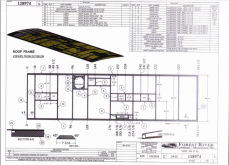CarlCruzin
New Member
I placed an order in the group buy for 16x 280ah cells. So far this is my only purchase, but they are going to take a month or two to arrive and I'm trying to have everything else in order or installed so they will be the last step once they arrive.
Once I have the hardware components selected, I plan to make a wiring diagram so I can have those more knowledgeable than me review it for safety and effectiveness.
I will post pictures as the project progresses so hopefully it can be a helpful resource for others.
My original plan was to go 48v, but I'm pretty sure I will do 24v with 8s2p for the following reasons:
1. Hydraulic levelers are on a 100A breaker. I can't find a 48v to 12v 100A converter, but a 24v to 12v 100A is available and reasonably priced
2. I like the option of using a 12v/24v dc to dc converter to charge the battery bank while driving
3. Shock hazard of 48v vs 24v
4. It doesn't seem like there is a compelling reason to do 48v except for a single BMS
Current Build Plan:
- 24v 560ah 8s2p LifePo4 battery bank (Ordered)
- 2x 8s BMS (Still sourcing, recommendations?)
- 24v 3kw All-in-One Inverter/Charger/MPPT/Transfer Switch: Growatt spf-3000tl-lvm-24p (proposed)
- 24v to 12v 100A converter for coach accessories: (on Amazon for $100) (proposed)
- 12v to 24v dc to dc converter for alternator charging: Victron Orion IP20 12/24 (proposed)
- Solar Panels 4x 320w in 2s2p: SolarTechDirect
- While I'm at it I plan to hardwire a 50a Surge Guard
Aside from the above items that my research has led me to believe are good choices, there are other things I need to figure out:
- How to properly mount 4x of the 66.3"x39.2" panels
- Wire, fuse, breaker locations and sizing
Once I have the hardware components selected, I plan to make a wiring diagram so I can have those more knowledgeable than me review it for safety and effectiveness.
I will post pictures as the project progresses so hopefully it can be a helpful resource for others.
My original plan was to go 48v, but I'm pretty sure I will do 24v with 8s2p for the following reasons:
1. Hydraulic levelers are on a 100A breaker. I can't find a 48v to 12v 100A converter, but a 24v to 12v 100A is available and reasonably priced
2. I like the option of using a 12v/24v dc to dc converter to charge the battery bank while driving
3. Shock hazard of 48v vs 24v
4. It doesn't seem like there is a compelling reason to do 48v except for a single BMS
Current Build Plan:
- 24v 560ah 8s2p LifePo4 battery bank (Ordered)
- 2x 8s BMS (Still sourcing, recommendations?)
- 24v 3kw All-in-One Inverter/Charger/MPPT/Transfer Switch: Growatt spf-3000tl-lvm-24p (proposed)
- 24v to 12v 100A converter for coach accessories: (on Amazon for $100) (proposed)
- 12v to 24v dc to dc converter for alternator charging: Victron Orion IP20 12/24 (proposed)
- Solar Panels 4x 320w in 2s2p: SolarTechDirect
- While I'm at it I plan to hardwire a 50a Surge Guard
Aside from the above items that my research has led me to believe are good choices, there are other things I need to figure out:
- How to properly mount 4x of the 66.3"x39.2" panels
- Wire, fuse, breaker locations and sizing




